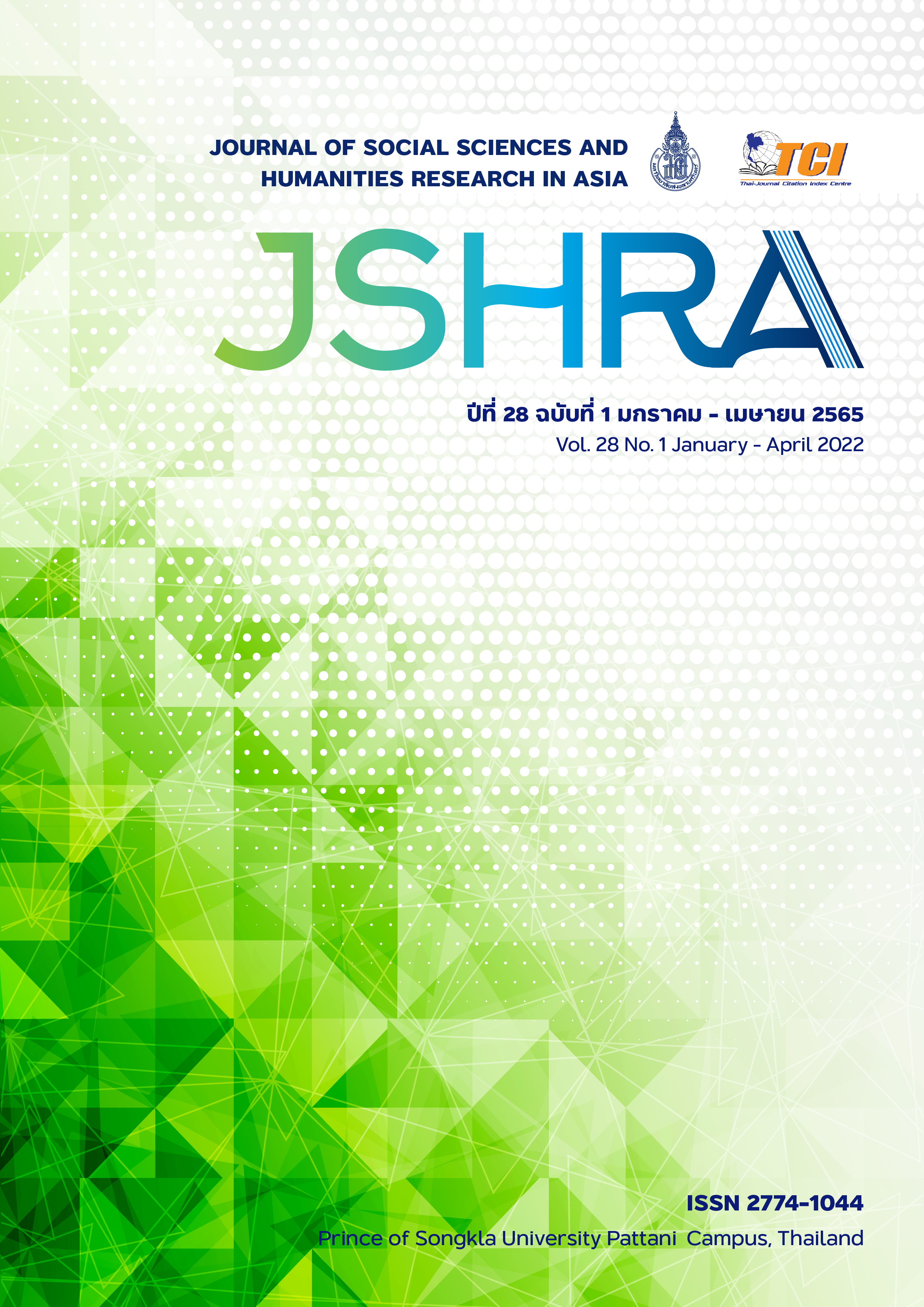ปัญหาอุปสรรคและเทคนิคการเอาชนะประสบการณ์ความสะเทือนใจทางวัฒนธรรมของครูต่างชาติในโรงเรียนเอกชนแห่งหนึ่งในไทย
คำสำคัญ:
ครูต่างชาติ, ความสะเทือนใจทางวัฒนธรรม, ประสบการณ์ความสะเทือนใจทางวัฒนธรรมบทคัดย่อ
การศึกษาครั้งนี้เป็นการศึกษาปัญหาอุปสรรคและเสนอแนะเทคนิคการเอาชนะประสบการณ์ความสะเทือนใจทางวัฒนธรรมเมื่อทำงานในโรงเรียนเอกชนแห่งหนึ่งในประเทศไทย เพื่อทำความเข้าใจประสบการณ์ทางสังคมโดยใช้กระบวนทัศน์ทางความรู้แบบสร้างสรรค์สังคมด้วยรูปแบบการวิจัยเชิงคุณภาพ เพื่อแก้ไขปัญหาทางการวิจัยในรูปแบบยุทธศาสตร์การวิจัยเชิงปรากฏการณ์วิทยา การคัดเลือกผู้ให้ข้อมูลใช้วิธีการคัดเลือกการสุ่มตัวอย่างแบบมีเกณฑ์และแบบลูกโซ่ การเก็บรวบรวมข้อมูลโดยการสัมภาษณ์แบบกึ่งโครงสร้างกับครูต่างชาติจำนวน 14 คนที่ทำงานในโรงเรียนเอกชนแห่งหนึ่งของประเทศไทย การวิเคราะห์ข้อมูลตามขั้นตอนวิธีการวิเคราะห์ข้อมูลแบบเชิงปรากฏการณ์วิทยาของ Stevick-Colaizzi-Keen ผลการวิจัยพบว่า ปัญหาและอุปสรรคจากประสบการณ์ความสะเทือนใจทางวัฒนธรรมของครูต่างชาติที่ทำงานในโรงเรียนเอกชนแห่งหนึ่งในประเทศไทย มี 4 ประเด็น ได้แก่ 1) ระบบอาวุโสในโรงเรียน 2) ความแตกต่างด้านพฤติกรรม 3) ความไม่ชัดเจนกับการบริหารและนโยบายของโรงเรียน และ 4) อุปสรรคทางภาษา และเทคนิคการเอาชนะเพื่อจัดการกับประสบการณ์ความสะเทือนใจทางวัฒนธรรมเมื่อทำงานในโรงเรียนเอกชนแห่งหนึ่งในไทย ประกอบด้วย 3 ประเด็น ได้แก่ 5) การยอมรับหรือเพิกเฉย 6) ได้รับการสนับสนุนจากครูต่างชาติคนอื่นๆ และ 7) เทคนิคต่างๆ ที่ใช้ในการแก้ปัญหาด้านอุปสรรคทางภาษา
เอกสารอ้างอิง
Adler, P.S. (1975). The transitional experience: An alternative view of culture shock. Journal of
Humanistic Psychology, 15(4), 13-23. http://dx.doi.org/10.1177/002216787501500403
American Geriatrics Society (AGS). (2019). Adapting to a new culture. Retrieved April 30, 2019,
from https://www.agsmovers.com/news/adapting-to-a-new-culture/
Bhatia, K. (2015). Managing cultural shock due to globalization- Issues challenges and opportunities. Proceedings of the third Asia-Pacific conference on global business, economics, finance and banking. (AP15 Singapore Conference) (pp. 1-6). Singapore.
Befus, C.P. (1988). A multilevel treatment approach for culture shock experienced by sojourners. International Journal of Intercultural Relations, 12(4), 381-400. https://doi.org/10.1016/0147-1767(88)90032-6
Bock, P.K. (1970). Culture shock. In Bock, P.K. (Ed.). Culture shock: A reader in modem cultural anthropology (pp. 9-12). New York: Alfred A. Knopf.
Bogdan, R.C., & Biklen, S.K. (1992). Qualitative research for education: An introduction to theories and methods (2nd ed.). Boston: Pearson Education.
Chen, A.S., Lin, Y., & Sawangpattanakul, A. (2011). The relationship between cultural intelligence and performance with the mediating effect of culture shock: A case from Philippine laborers in Taiwan. International Journal of Intercultural Relations, 35(2), 246-258.
Clerck, D., Marie-Lou, H., Roos, W., Christiane, T., & Jorgen, C. (2011). Instruments and guidelines for qualitative fieldwork. EUMAGINE, Project Paper 6B.
Creswell, J.W. (2013). Qualitative inquiry and research design: Choosing among five traditions (3 rd ed.). Thousand Oaks, CA: Sage.
Cushner, K. (Ed.). (1998). International perspectives on intercultural education. New York: Routledge.
David, K. (1971). Culture shock and the development of self-awareness. Journal of Contemporary Psychotherapy, 4(1), 44-48.
David, N. (2015). International student’s challenge and adjustment to college. Education Research International, 2015, 1-9. http://dx.doi.org/10.1155/2015/202753
Dreamreader. (2015). Culture shock. Retrieved May 6, 2019, from http://dreamreader.net/lesson/culture- shock/
Esl, S. (2017). How to deal with culture shock when teaching English abroad. Retrieved May 3, 2019, from https://www.eslstarter.com/community/articles/2017-12-07-how-to-deal- with-culture-shock- when-teaching-english-abroad
Essays, U.K. (2018). Culture shock of studying abroad cultural studies essay. Retrieved April 10, 2019, from https://www.ukessays.com/essays/cultural-studies/culture-shock-of-studying- abroad- cultural-studies-essay.php?vref=1
Farah, B., & Sarah, A. (2017). Culture shock among international students: A case study at the university of Tlemcen. Retrieved April 10, 2019, from http://dspace.univ- tlemcen.dz/bitstream/112/11008/1/belhadi-ayad.pdf
Fontaine, G. (1989). Managing international assignments: The strategy for success. New Jersey: Prentice Hall.
Furnham, A., & Bochner, S. (1986). Culture shock: Psychological reactions to unfamiliar environments. New York: Routledge.
Gardner, H. (1983). Frames of mind: The theory of multiple intelligences. New York: Basic Books.
Garza-Guerrero, A.C. (1974). Culture shock: Its mourning and vicissitudes of identity. Journal of the American Psychoanalytic Association, 22(20), 408-429.
Gilton, D.L. (2005). Culture shock in the library: Implications for information literacy instruction.Research Strategies, 20(4), 424-432. http://dx.doi.org/10.1016/j.resstr.2006.12.013
Hall, E.T. (1961). The hidden dimension. New York: Doubleday.
Harris, P.R., & Moran, R.T. (1987). Managing cultural differences. New York: Routledge.
Hill, C.W.L., & Hult, G.T.M. (2016). Global business today (9th ed.). New York: McGraw-Hill Education.
Hisam, T.G. (1997). The value of expatriate support programs in the susceptibility to culture
shock for American expatriated employees’ working in Germany. United States: UMI Company.
Hofstede, G. (1984). National cultures revisited. Asia Pacific Journal of Management, 2, 22-28. http://dx.doi.org/10.1007/BF01732507
Hofstede, G. (2001). Culture’s consequences: Comparing values, behaviors, institutions and organizations across nations. California: Sage.
Investopedia. (2018). Culture shock. Retrieved April 11, 2019, from https://medcraveonline.com/ SIJ/SIJ-02-00063.pdf
Javadpour, A., & Samiei, S. (2017). Motivation and barriers to participation in virtual knowledge- sharing communities of practice. Management Science Letters, 7(2), 81-86.
John, M. (2017). To boost failing Thai education, give foreign teachers proper contracts. Retrieved May 2, 2019, from https://www.nationmultimedia.com/detail/your_say/30333993
Juffer, K.A. (1985). Researching culture shock: The Culture shock adaptation inventory. Action Research & Associates, Inc.
Kohls, L.R. (1979). Survival kit for overseas living. Boston: Nicholas Brealey.
Kohls, L.R. (1984). Survival kit for overseas living (2nd ed.). Boston: Nicholas Brealey.
Komin, S. (1990). Culture and work-related values in Thai organizations. International Journal of Psychology, 25(3-6), 681-704.
Kluckhohn, C. (1961). Universal categories of culture. In Frank, W.M. (Ed.). Readings in cross- cultural methodology (pp. 89-105). Massachusetts: Harvard University.
Kron, K., & Faber, C. (1973). How does the teacher cope with the culture shock? The Clearing House, 47(8), 506-508.
Lakshmi, V.S., & Ramchandran, S. (2016). A phenomenological study about the international student’s cultural shock in India. Australian Journal of Basic and Applied Sciences, 10(1), 631-635. https://ssrn.com/abstract=2791566
Lane, P. (2002). A beginner’s guide to crossing cultures: Making friends in a multicultural world. Illinois: Intervarsity.
Longstreet, W. (1978). Aspects of ethnicity. New York: Teachers College Press.
Moustakas, C. (1994). Phenomenological research methods. California: Sage.
Mulder, N. (1996). Inside Thai society: Interpretation of everyday life. Bangkok: Pepin Press.
National Education Information System. (2016). The number of the Ministry of Education’s Personnel in academic year 2016 classified by type of personnel and agency, Retrieved February, 10, 2021, from http://www.mis.moe.go.th/index.php?option=com_content &view=article&id=557&Itemid=113
Nagler, M. (1977). Dread goddess endowed with speech. Archaeological News, 6, 77–85.
Naoki, O. (1991). Inter cultural adjustment of Japanese high school exchange students in the United States on a one-year home-stay program. University Microfilms International: A Bell & Howell Information Company.
OECD-UNESCO. (2016). Education in Thailand: An OECD-UNESCO perspective: Reviews of national policies for education. Paris: OECD Publishing.
Oberg, K. (1954). Culture shock. Indianapolis: Bobbs-Merril Series in Social Sciences.
Oberg, K. (1960). Cultural shock: Adjustment to new cultural environment. Practical Anthropology, 4, 177-182.
Oumi, M. (1990). Culture shock. In Kamakura, K. (Ed.), Her Japanese girlfriend, Kamakura (pp. 118-144). Tokyo: Hokuju Shuppan.
Owen, R.B. (2002). The effects of hardiness on culture shock and cross-cultural adaptation in an overseas missionary population. UMI: ProQuest Information and Learning Company.
Patton, M.Q. (1990). Qualitative research and evaluation methods (2nd ed.). California: Sage.
Pedersen, P. (1995). The five stages of culture shock: Critical incidents around the world. Connecticut: Greenwood Press.
Pedersen, P. (2004). 110 Experiences for multicultural learning. Washington: American Psychological Association.
Peoples, J., & Bailey, G. (2009). Humanity: An introduction to cultural anthropology. Belmont: Wadsworth Cengage Learning.
Peter, D. (2012). Hierarchy in the public-school system. Retrieved April 10, 2019, from https://blogs.edweek.org/edweek/finding_common_ground/2012/01/hierarchy_in_the_public_sc hool_system.html
Pimpa, N. (2009). Learning problems in transnational business education and training: The case of MBA in Thailand. International Journal of Training and Development, 13(4), 262-279. http://dx.doi.org/10.1111/j.1468-2419.2009.00331.x
Photiyarach, R. (2017). Communication styles: A case study of the United States, Germany and Thailand. Retrieved February, 10, 2021, from Intercultural communication styles: A case study of the United States, Germany and Thailand (linkedin.com)
Photiyarach, R. (2017). 15 cultural differences between Americans, Germans and Thais. Retrieved November 5, 2017, from https://www.linkedin.com/pulse/10-cultural-differences-between-thais- germans-rachawit-photiyarach
Renan, S. (2014). Culture shock an obstacle for EFL learners. Procedia - Social and Behavioral Sciences, 114, 533 – 537. https://doi.org/10.1016/j.sbspro.2013.12.742
Richard, A.E., & Caroline, H. (2008). Seeing with young eyes: UNESCO Bangkok. Retrieved February, 10, 2021, from https://unesdoc.unesco.org/ark:/48223/pf0000179114
Rhinesmith, S.H. (1985). Bring home the world: A management guide for community leaders of international exchange programs. New York: Walker and Company.
Ross, P.G., & Krider, D.S. (1992). Off the plane and into the classroom: A phenomenological explication of international teaching assistants’ experiences in the American classroom. International Journal of Intercultural Relations, 16(3), 277-293. https://doi.org/ 10.1016/0147-1767(92)90053-W
Sarah, I. (2017). Bridge the language barrier with language translation technology. Retrieved May 3, 2019, from https://www.useoftechnology.com/bridge-the-language-barrier-with-language-translation- technology/
Sitton, T. (1976). The pedagogy of culture shock. The Social Studies, 67(5), 206-212.
Spencer-Oatey, H. (2008). Culturally speaking, culture, communication and politeness theory(2nd ed.). London: Continuum.
Stabbackdr, P., Malems, B., & Georgescu, D. (2011). What makes a good quality school curriculum? Paris: UNESCO-IBE.
Symthe, J.L. (2012). Culture shocked: The intercultural experiences and insights of returned peace corps volunteer educators. Retrieved February, 10, 2021, from https://hdl.handle.net/11244/7584
Valle, R., King, M., & Halling, S. (1989). An introduction to existential- phenomenological thought in psychology. In Valle, R., & Halling, S. (Eds.). Existential phenomenological perspective in psychology (pp. 3-16). New York: Plenum Press.
Xin, L. (2018). Teaching experiences of Chinese teachers teaching the Chinese language in Thai public schools in Chonburi. Thailand: Published by Burapha University.
Zapf, M.K. (1991). Cross-cultural transitions and wellness: Dealing with culture shock. International Journal for the Advancement of Counselling, 14(2), 105- 119.











